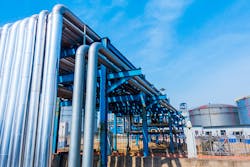The North American Energy Standards Board (NAESB) description of a typical natural gas composition was discussed in last month’s column. However, the actual natural gas composition at a given location may be significantly different than typical, as suggested by ranges of compositions provided by NAESB. Compositions vary with location, but the proliferation of shale gas production in North America, among other discoveries, has exasperated the situation. This occurrence begs the question of how different natural gas compositions can affect the measurement of the flow of natural gas — both personally (as a customer) and professionally. Let’s examine the personal side first.
This question is of interest personally because many or most of us cook and heat our homes with natural gas. Natural gas is delivered to customers at a nominal pressure set and controlled by the local gas company. Natural gas consumption in most houses and apartments is typically measured using a positive displacement diaphragm flowmeter designed and approved for natural gas custody transfer service. These flowmeters will measure the volume of natural gas accurately when the nominal natural gas pressure is maintained within tolerances and its temperature remains within a specified range.
However, varying composition can and will affect the heating value of a given volume of natural gas. Therefore, the heating value of actual natural gas at a given location could be different from a typical NAESB natural gas heating value by as much as a few percent. A higher (lower) heating value than typical would deliver more (less) thermal energy to the user in a given volume — decreasing (increasing) billing revenue for the same amount of thermal energy delivered. Extreme variations could potentially adversely affect combustion. To ensure that the natural gas provided to the customer contains the proper amount of energy per unit volume, natural gas companies typically monitor the heating value of their natural gas.
David W. Spitzer is a principal at Spitzer and Boyes, LLC, which offers engineering, focused market research, writing/editing white papers, strategic marketing consulting, distribution consulting, seminars and expert witness services for manufacturing and automation companies. Spitzer has written more than 400 technical articles and 10 books about flow measurement, instrumentation and process control. He can be reached at 845-623-1830 or via spitzerandboyes.com.



